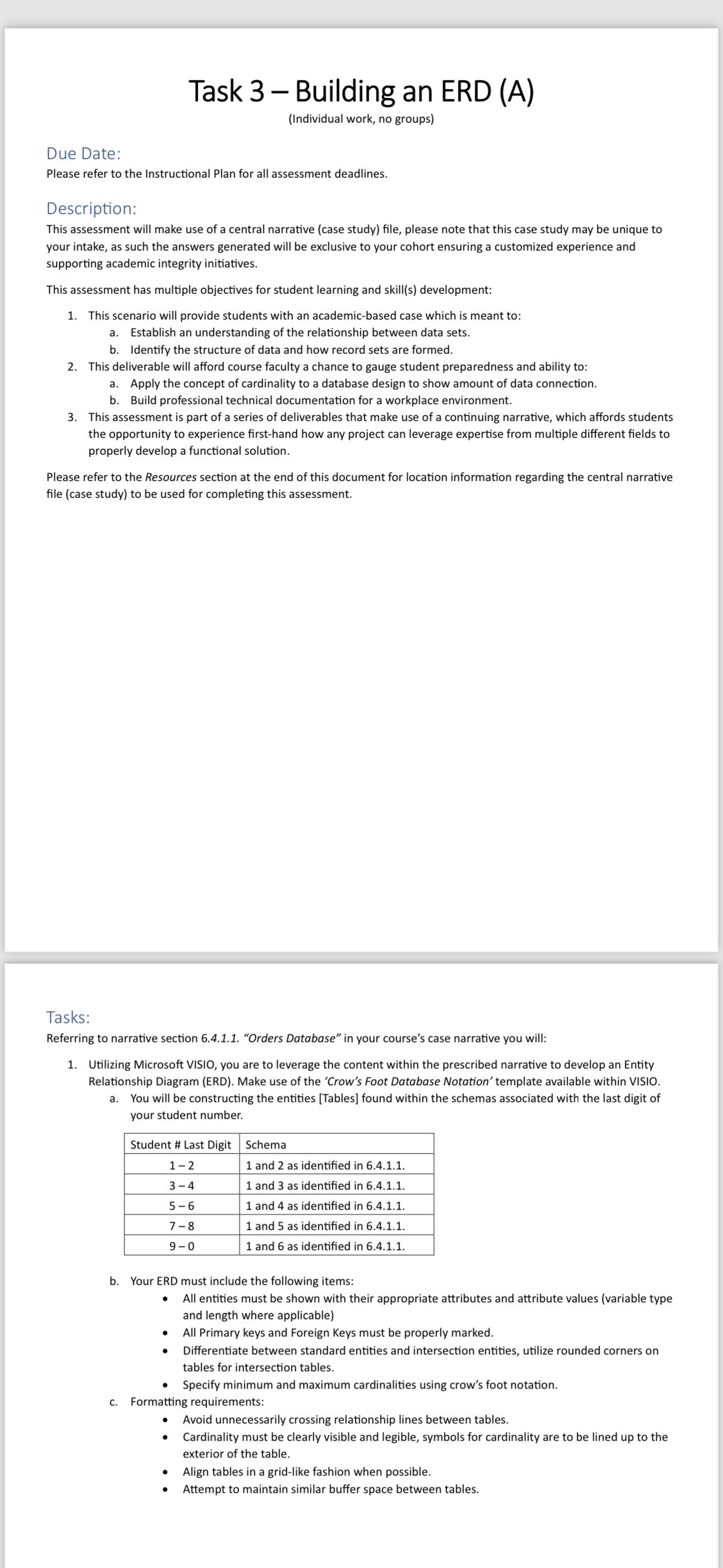Answered step by step
Verified Expert Solution
Question
1 Approved Answer
Task 3 - Building an ERD ( A ) ( Individual work, no groups ) Due Date: Please refer to the Instructional Plan for all
Task Building an ERD A Individual work, no groups Due Date: Please refer to the Instructional Plan for all assessment deadlines. Description: This assessment will make use of a central narrative case study file, please note that this case study may be unique to your intake, as such the answers generated will be exclusive to your cohort ensuring a customized experience and supporting academic integrity initiatives. This assessment has multiple objectives for student learning and skills development: This scenario will provide students with an academicbased case which is meant to: a Establish an understanding of the relationship between data sets. b Identify the structure of data and how record sets are formed. This deliverable will afford course faculty a chance to gauge student preparedness and ability to: a Apply the concept of cardinality to a database design to show amount of data connection. b Build professional technical documentation for a workplace environment. This assessment is part of a series of deliverables that make use of a continuing narrative, which affords students the opportunity to experience firsthand how any project can leverage expertise from multiple different fields to properly develop a functional solution. Please refer to the Resources section at the end of this document for location information regarding the central narrative file case study to be used for completing this assessment. Tasks: Referring to narrative section "Orders Database" in your course's case narrative you will: Utilizing Microsoft VISIO, you are to leverage the content within the prescribed narrative to develop an Entity Relationship Diagram ERD Make use of the 'Crow's Foot Database Notation' template available within VISIO. a You will be constructing the entities Tables found within the schemas associated with the last digit of your student number. tableStudent # Last Digit,Schema and as identified in and as identified in and as identified in and as identified in and as identified in b Your ERD must include the following items: All entities must be shown with their appropriate attributes and attribute values variable type and length where applicable All Primary keys and Foreign Keys must be properly marked. Differentiate between standard entities and intersection entities, utilize rounded corners on tables for intersection tables. Specify minimum and maximum cardinalities using crow's foot notation. c Formatting requirements: Avoid unnecessarily crossing relationship lines between tables. Cardinality must be clearly visible and legible, symbols for cardinality are to be lined up to the exterior of the table. Align tables in a gridlike fashion when possible. Attempt to maintain similar buffer space between tables. 
Task Building an ERD A
Individual work, no groups
Due Date:
Please refer to the Instructional Plan for all assessment deadlines.
Description:
This assessment will make use of a central narrative case study file, please note that this case study may be unique to your intake, as such the answers generated will be exclusive to your cohort ensuring a customized experience and supporting academic integrity initiatives.
This assessment has multiple objectives for student learning and skills development:
This scenario will provide students with an academicbased case which is meant to:
a Establish an understanding of the relationship between data sets.
b Identify the structure of data and how record sets are formed.
This deliverable will afford course faculty a chance to gauge student preparedness and ability to:
a Apply the concept of cardinality to a database design to show amount of data connection.
b Build professional technical documentation for a workplace environment.
This assessment is part of a series of deliverables that make use of a continuing narrative, which affords students the opportunity to experience firsthand how any project can leverage expertise from multiple different fields to properly develop a functional solution.
Please refer to the Resources section at the end of this document for location information regarding the central narrative file case study to be used for completing this assessment.
Tasks:
Referring to narrative section "Orders Database" in your course's case narrative you will:
Utilizing Microsoft VISIO, you are to leverage the content within the prescribed narrative to develop an Entity Relationship Diagram ERD Make use of the 'Crow's Foot Database Notation' template available within VISIO.
a You will be constructing the entities Tables found within the schemas associated with the last digit of your student number.
tableStudent # Last Digit,Schema and as identified in and as identified in and as identified in and as identified in and as identified in
b Your ERD must include the following items:
All entities must be shown with their appropriate attributes and attribute values variable type and length where applicable
All Primary keys and Foreign Keys must be properly marked.
Differentiate between standard entities and intersection entities, utilize rounded corners on tables for intersection tables.
Specify minimum and maximum cardinalities using crow's foot notation.
c Formatting requirements:
Avoid unnecessarily crossing relationship lines between tables.
Cardinality must be clearly visible and legible, symbols for cardinality are to be lined up to the exterior of the table.
Align tables in a gridlike fashion when possible.
Attempt to maintain similar buffer space between tables.
Step by Step Solution
There are 3 Steps involved in it
Step: 1

Get Instant Access to Expert-Tailored Solutions
See step-by-step solutions with expert insights and AI powered tools for academic success
Step: 2

Step: 3

Ace Your Homework with AI
Get the answers you need in no time with our AI-driven, step-by-step assistance
Get Started


